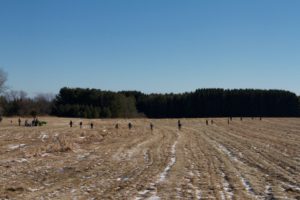This is being written just before Thanksgiving, which lends itself to sentimental reflection of the state of our lives. Despite the perception of some regarding those who work to preserve the environment, at Woodland Dunes we feel there is much to be thankful for.
I am most thankful for the beautiful preserve which Bernie Brouchoud and others set out to protect. Decades ago, it was viewed as a swamp of little value, a place to dump trash. Now, we realize that it is an important piece of a much bigger puzzle, and a place where life of all kinds can find refuge and learning. A place worthy of respect.
I am also grateful for the knowledge of the tremendous power of people. People have the capacity to do almost anything they set their minds to. In the case of Woodland Dunes, people decided to save this wild place rather than destroy it. There were times of tremendous struggle as it was debated whether it should be used for the profit of some or the benefit of all. The decision to pursue the latter was at first tenuous, but more and more the value was realized. There was a realization that common sense is not restricted only to dollars earned, although wise management and profit can now be seen to go hand-in-hand.
So it seems odd to think that with all the natural wonders of the Dunes and our Lakeshore, that possibly it’s people who deserve the most appreciation – but I think that may be the case. Let me tell a little story:
Woodland Dunes is a farm for wildlife. We learn about it, plant it, and tend it. The harvest (the wildlife and experiences that are grown), harvest and disperse themselves. The wildlife are all parts of a large ecological system that can sustain itself with a little help from us. We can harvest: a sense of peace and wonder, learning experiences for our children, exercise, and enjoyment without destroying the system. We apply science to try to make things even better, identifying where things aren’t as good as they could be, and fixing them, to the best of our ability. On a traditional farm, many of the crops are planted in the spring, but in nature plants develop their seeds over the growing season and sow them in the fall.
Recently, we decided to try to enhance some of our grassland acres, enrolling them in the Conservation Reserve or CRP program. We looked at 70 acres of grassland which already had native grassland species planted and growing, but sought to change the balance to include more plants which benefit pollinators- bees and butterflies and other insects. Like any farming operation, preparation and planting are tricky things, weather dependent and all. This year, the cold wet fall presented challenges, but there were windows where preparation of the fields could occur. Then comes planting, which is a challenge given the amount of thick cover still on the fields. A date was set, and a request sent out for volunteers to help with wildflower seeding. We had hoped for a dozen, maybe two, to help our staff with the task. Sure enough, people responded, and when the date came, a nearly perfect late fall day with sun and little wind, nearly 40 people showed up to scatter hundreds of pounds of wildflower seed on the site. These people gave of their time on a weekday in November to cheerfully help us make part of the preserve a better place. So out we went, volunteers and three of our staff plus an intern, and in two hours were able to complete the seeding, just in time for snow in following days to help settle the seeds and begin the process of incorporating them into the soil. These seeds need a period of rest and cold before they will germinate and conditions were ideal to start that process. When we were finished, all we could do was humbly thank our helpers, and marvel at what had just happened.
So now we will wait, thinking about all that new life bathing itself in the needed cold and snow before sprouting next year, and the several following years of development of the plants. And ultimately how this growth will help not only Woodland Dunes but surrounding landowners by provided habitat crucial for the survival of the little insects that pollinate our crops.
This experience reminds us of the generosity within our community and the good people who are willing to help. Like the prairie, the seeds of this community are sown in the fall and early winter when we celebrate the holidays- they are the examples that we put forth for others to see. And like the wildflower seeds they will take time to mature. So perhaps this year we should direct our thoughts a little bit more toward how we can sow the seeds of helpfulness. Just like wildlife needs our help to sustain itself, we also need to find better ways to sustain each other.
And thank you to all who help us… and others.
photo- volunteers seeding wildflowers at Woodland Dunes

